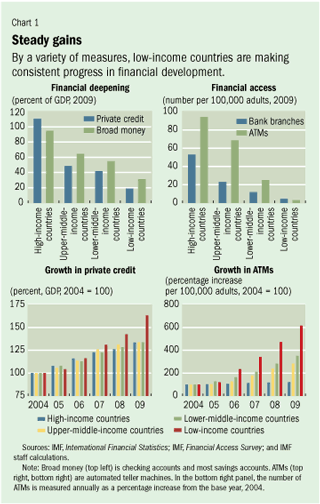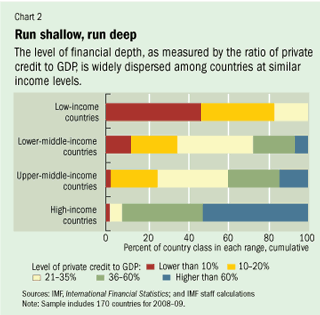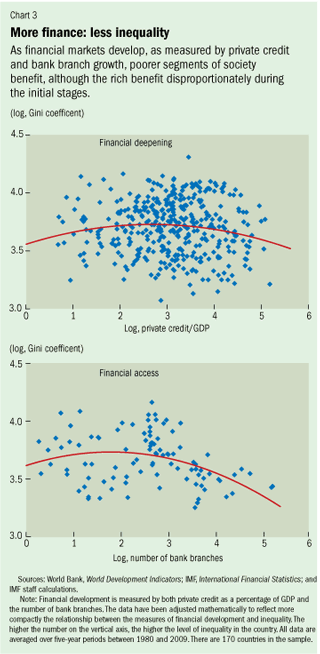A Bigger Slice of a Growing Pie
Finance & Development, September 2011, Vol. 48, No. 3
Sarwat Jahan and Brad McDonald
Developing the financial sector accelerates economic growth and can enhance income equality
ECONOMIC development and financial development reinforce each other. That should come as no surprise. More varied and more accessible financial services—from banking to insurance to stock markets—permit larger pools of savings to be channeled with increasing efficiency toward productive investments that result in stronger growth. But to the surprise of some, there is mounting evidence that financial development does not merely enlarge the pie, but also divides it more evenly.
For the bottom fifth of society, about 60 percent of the benefit of financial development comes from overall economic growth and 40 percent from greater income equality (Beck, Demirgüç-Kunt, and Levine, 2007).
This is important for countries at all income levels. But for the developing world and especially for many low-income countries—where indicators of financial development are strengthening rapidly—it also provides reason for optimism that faster rates of poverty reduction may lie ahead.
This link between equality and financial development raises an urgent question for policymakers: How can governments promote financial development that supports growth and reduces inequality, with adequate financial and economic stability? Experience provides few firm rules, only some broad guidance. Just like economic reforms more generally, the pace and approach of financial liberalization should be tailored to a country’s situation and complement its policies in other areas. A foundation of a stable macroeconomic environment and flexible trade, product, and labor markets can influence the success of a financial development strategy. From there, the more successful strategies will identify and remove impediments to financial access—such as policies that inhibit competition—without directing particular outcomes. Successful strategies will also be mindful of the damage financial instability inflicts, on growth and particularly on lower-income members of society.
Across the globe

Financial development differs markedly around the world (see Chart 1). The increase in the level of financial services is often called financial deepening. When measured by the ratio of private credit to gross domestic product (GDP), high-income countries are on average about six times deeper than low-income countries. A similar observation holds for another indicator of financial deepening, the ratio of M2 to GDP. M2 is a measure of the money supply that includes cash, checking, and saving accounts. Encouragingly, although they have much lower levels of financial depth, the low-income countries are experiencing financial deepening at rates far faster than higher-income countries. Over the period 2004–09, cumulative average growth of private credit–to-GDP ratios in low-income countries was about 63 percent, compared with 33 percent for all other income groups.
But financial deepening will be of low quality if financial services are available to only a few firms or households. Access to finance is as pivotal as the depth of the financial system. High-income countries have on average 12 times more bank branches per 100,000 adults than the average low-income country—and 30 times more automated teller machines. Still, access to financial services in low-income countries is growing. The average number of bank branches per 100,000 people in low-income countries increased by about 31 percent during 2004–09; over the same period, growth of bank branches was stagnant for high-income countries, and between 5 and 20 percent for low- to upper-middle-income countries.

The level of financial depth is also widely dispersed among countries at similar income levels (see Chart 2). Among the low-income countries, the median country has a ratio of private credit–to-GDP of 10 percent, while about 17 percent have ratios between 20 to 35 percent. The median private credit–to-GDP ratio for lower-middle-income and upper-middle-income countries are respectively 24 and 29 percent, but there is significant dispersion. The median high-income country has a private credit–to–GDP ratio of 62 percent, but nearly 8 percent of high-income countries have ratios below 35 percent.
Financial development and inequality
Financial development enables bigger investments and more productive allocation of capital, which lead to higher income growth. But the benefits of financial development extend beyond financing investment, and often start by offering better and cheaper services for saving money and making payments. These services allow firms and households to avoid the cost of barter or cash transactions, cut the costs of remitting funds, and provide the opportunity to accumulate assets and smooth income. Insurance services help firms and households cope with shocks and reduce their vulnerability to adverse situations, reducing the risk of falling into poverty. Well-developed domestic financial markets may be instrumental in moderating boom-bust cycles triggered by sudden stops in financial flows.
Financial market imperfections—such as informational asymmetries (when one side knows more about a transaction than the other does), transaction costs, and contract enforcement costs—may hamper poor entrepreneurs, who generally lack collateral, credit histories, and connections. These credit constraints will impede the flow of capital to poor individuals with high-return projects. Some economic models, therefore, show that financial development reduces poverty and income inequality directly, by disproportionately relaxing credit constraints on the poor, and indirectly, by improving the allocation of capital and accelerating growth.
Other models suggest that financial development may initially increase inequality before ultimately reducing it. The poor rely primarily on the informal sector for capital, so improvements in the formal financial sector help mainly the rich. Some models suggest that at early stages of development, only the rich can afford to access and profit from financial markets, so financial development intensifies income inequality. At higher levels of economic development, financial development helps an increasing proportion of society.
The evidence

Simple cross-country patterns indicate that income inequality is lower in countries with deeper and more accessible financial markets. Using the Gini coefficient to measure inequality, we find that a more developed financial system tends to have less income inequality, although there is much variation. The Gini coefficient ranges from zero, when all households have the same income, to 100 when one household has all the income. Both financial depth, as measured by private credit to GDP, and financial access, measured by the number of bank branches (see Chart 3), indicate an initial benefit to the richer segments of society, but as financial development progresses, poorer segments benefit—and as access increases, inequality declines more sharply.
A growing body of empirical work also finds support for the influence of financial development on reducing inequality, particularly after controlling for income levels, other country characteristics, and potential reverse causality (that is, the possibility that declining inequality triggers financial development). Cross-country analysis shows that: Gini coefficients fall more rapidly in countries with more developed financial intermediaries (such as banks or insurance companies); with better developed financial intermediaries, the income of the poorest 20 percent of the population grows faster than the national average; and the percentage of the population living on less than one or two dollars a day falls more rapidly with higher levels of financial development (Beck, Demirgüç-Kunt, and Levine, 2007).
Country-specific studies reach the same conclusions. An impact study of bank branches in rural India found that output increased and poverty declined with greater access to finance (Burgess and Pande, 2005), and another showed that greater access to bank branches lowered income inequality in the United States (Beck, Levine, and Levkov, 2010).
Benefits of financial development extend beyond income equality to other poverty indicators. Countries with well-developed financial systems seem to have a lower incidence of poverty than others at the same level of national income. A 10 percentage point increase in the private credit–to-GDP ratio reduces the percentage of the population in poverty by 2.5 to 3 percentage points (Honohan, 2004). Similarly, a 1 percentage point increase in private credit to GDP reduces the prevalence of undernourishment by 0.2 to 2.5 percentage points (Claessens and Feijen, 2007). There is also evidence that financial development improves societal health, education, and gender equality and reduces child labor.
However, not all financial development reduces inequality, at least in the short run. For example, a study of stock market liberalization in emerging markets shows that the benefits accrue primarily to the rich at the expense of middle-income citizens. Similarly, financial globalization, especially when it comes to foreign direct investment, has been associated with widening income disparities (IMF, 2007). More generally, there is a risk that small groups of elites may capture the process of financial liberalization, directing it in ways that narrow rather than broaden access (Claessens and Perotti, 2007).
How much is enough?
While properly functioning financial systems can support growth, too much financial sector development can also bring risks. Empirical estimates find that financial development can cause volatility of output growth, which increases when credit to the private sector exceeds 100 percent of GDP (Easterly, Islam, and Stiglitz, 2001). Thresholds for what is “too much” depend not only on the level of financial development, but also on other country characteristics such as the quality of institutions—including the regulatory framework and financial supervision. When institutions are weaker, the integration of a country’s financial markets with those in other countries may contribute to increased macroeconomic volatility (such as in growth and unemployment).
Developing countries are often far from these thresholds, but they are also becoming more exposed to turmoil induced by the financial sector. Poverty has tended to rise in economic crises, as social spending suffers and aid stagnates, pinning the livelihood of the poor to often underdeveloped social safety nets.
Helping the poor
The evidence that financial development fosters growth and strongly benefits poorer segments of society is good news for poverty reduction and income equality. Particularly for low-income countries, recent trends in financial development indicators may portend a sustained period of strong and progressively inclusive growth. How can this rather hopeful trend be supported? Several key policy areas are important.
Financial and macroeconomic stability: A stable macroeconomy helps attract domestic and foreign investment, which is one key way financial development translates to growth. Taxing and spending policy and debt management can help directly, by averting excessive domestic debt that would reduce the pool of funds available for private investment. And while episodes of financial instability seem to affect incomes disproportionately at the top end, the poor are ill prepared to deal with any income decline (Honohan, 2005).
Other structural reforms: Evidence of the interplay between structural reforms emphasizes that those concerning product markets—such as trade, agriculture, and domestic services—make financial development strategies more successful in fostering stable growth. The enhanced profitability and solvency of domestic firms that result from product market reforms seem to lead to improved credit availability (Ostry, Prati, and Spilimbergo, 2008).
Legal environment and financial market infrastructure: Surveys, such as the World Bank’s Doing Business, shed light on the role of property rights and contract enforceability in financial development. Balanced, transparent, and timely processes for securing collateral in the event of loan defaults encourage financial institutions to lend to more and smaller firms, promoting a competitive and dynamic business sector. In larger and more developed economies, the emphasis should include developing capital markets.
Promoting financial access: Despite the recent growth, financial systems remain small in low-income regions, especially in much of sub-Saharan Africa. In banking, which is the dominant source of finance in these regions, the high spreads between deposit and lending rates reflect a lack of competition and inhibit firms from growing to take advantage of economies of scale. Banking sector liberalization that promotes competition (and takes due consideration of stability) boosts growth: the IMF estimated that the annual growth rate of developing economies with more open banking sectors exceeded that of economies with less open banking sectors by about 1 percentage point (Ostry, Prati, and, Spilimbergo, 2008).
Fostering integration: One way to enhance banking sector competition and promote financial access is through global and regional integration. For example, opening up the domestic banking market at an appropriate pace and with supporting reforms brings benefits for economies of all sizes. For those economies where a smaller scale of operations means higher operating costs, it also brings a “pro-competition” effect that promotes access by driving down prices and enhancing the range of banking services provided. This “opening up” can be achieved by allowing subsidiaries of foreign banks to incorporate domestically or by allowing branches of foreign banks. Complementary steps toward regulatory harmonization and supervisory cooperation also promote competition. Trade agreements at the multilateral and regional levels have developed to facilitate and provide an external anchor for such reforms.
These strategies emphasize financial development generally—evidence on particular strategies that may do more to reduce poverty is still limited. But some areas warrant emphasis. With poverty often concentrated in rural areas, regulators can ensure that loan classification criteria and capital requirements are not biased against loans to the agricultural sector, where many of the poor work. In developing countries, exploiting new technologies can provide financial access to those who were previously shut out. For example, Kenya’s “mobile money” programs, which allow the poor to use their cell phones to bank, have successfully broadened financial access while reducing transaction costs and facilitating trade (IMF, 2011). ■
Sarwat Jahan is an Economist and Brad McDonald is a Deputy Unit Chief in the IMF’s Strategy, Policy, and Review Department.
References
Beck, Thorsten, Asli Demirgüç-Kunt, and Ross Levine, 2007, “Finance, Inequality and the Poor,” Journal of Economic Growth, Vol. 12, No. 1, pp. 27–49.
Beck, Thorsten, Ross Levine, and Alexey Levkov, 2010, “Big Bad Banks? The Winners and Losers from Bank Deregulation in the United States,” Journal of Finance, Vol. 65, No. 5, pp. 1637–67.
Burgess, Robin, and Rohini Pande, 2005, “Do Rural Banks Matter? Evidence from the Indian Social Banking Experiment,” American Economic Review, Vol. 95, No. 3, pp. 780–95.
Claessens, Stijn, and Erik Feijen, 2007, “Financial Sector Development and the Millennium Development Goals,” World Bank Working Paper No. 89 (Washington: World Bank).
Claessens, Stijn, and Enrico Perotti, 2007, “Finance and Inequality: Channels and Evidence,” Journal of Comparative Economics, Vol. 35, No. 4, pp. 748–73.
Easterly, William, Roumeen Islam, and Joseph Stiglitz, 2001, “Shaken and Stirred: Explaining Growth Volatility,” in Annual World Bank Conference on Development Economics, ed. by Boris Pleskovic and Nicholas Stern (Washington: World Bank).
Honohan, Patrick, 2004, “Financial Development, Growth and Poverty: How Close Are the Links?” Policy Research Working Paper No. 3203 (Washington: World Bank).
———, 2005, “Banking Sector Crises and Inequality,” Policy Research Working Paper No. 3659 (Washington: World Bank).
International Monetary Fund (IMF), 2007, World Economic Outlook (Washington, October).
———, 2011, “The East African Community: Taking Off?” in Regional Economic Outlook: Sub-Saharan Africa (Washington, April).
Ostry, Jonathan David, Alessandro Prati, and Antonio Spilimbergo, eds., 2008, Structural Reforms and Economic Performance in Advanced and Developing Countries (Washington: International Monetary Fund).


